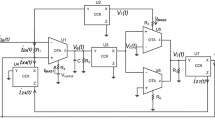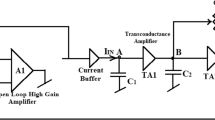Abstract
The memelement emulation using Operational Transconductance Amplifiers (OTAs) has been quite popular in the last decade. Interestingly, a detailed literature survey reveals that only voltage-biased OTAs have been used so far, for their emulators, which may be due to the ease of linear memelement function realization (through just bias voltage application by employing a capacitance). But this technique has disadvantages; most commercially available OTAs are current biased, voltage biasing does not provide a better range for tunability, and current biasing is more stable and can be easily provided through current mirrors in large circuits. Therefore, the presented work proposes a Universal memelement emulator (UME) using only current-biased Active elements (which are purely off-the-shelf). The developed UME uses four single output OTAs, one CCII (Second Generation Current Conveyor) along with only three grounded passive elements. Overall, the designed circuit configuration is based on just forty CMOS transistors, which is the least as compared to other existing UMEs. And also, the exhibited operating frequency limit is found to be in the MHz range for memristor and above 100 kHz for other realized memelements. The paper also describes the application examples of proposed UME in the relaxation oscillator and in a neuromorphic circuit exhibiting the Amoeba behavior. To verify the designed circuits, the simulations have been executed in PSPICE using 0.18 µm CMOS technology. Lastly, the realization of the proposed UME has been shown via commercial ICs; LM13700 and AD844, and results are presented.
























Similar content being viewed by others
Data availability
Data sharing not applicable to this article as no datasets were generated or analysed during the current study.
Code availability
Not Applicable.
References
Chua, L. O. (1971). Memristor-the missing circuit element. IEEE Trans. Circuit. Theory, 18, 507–519.
Strukov, D. B., Snider, G. S., Stewart, D. R., & Williams, R. S. (2008). The missing memristor found. Nature, 453, 80–83.
Biolek, D., Senani, R., Biolkova, V., & Kolka, Z. (2008). Active elements for analog signal processing: Classification, review and new proposals. Radioengineering, 17(4), 15–32.
Gupta, S., & Rai, S. K. (2020). New Grounded and Floating Decremental/Incremental Memristor Emulators Based on CDTA and Its Application. Wireless Personal Communications, 113, 773–798.
Yadav, N., Rai, S. K., & Pandey, R. (2020). New grounded and floating memristor emulators using OTA and CDBA. International Journal of Circuit Theory and Applications, 48(7), 1154–1179.
Yesil, A., Babacan, Y., & Kacar, F. (2020). An electronically controllable, fully floating memristor based on active elements: DO-OTA and DVCC. AEU-International Journal of Electronics and Communications, 123, 153315.
Babacan, Y., Yesil, A., & Kacar, F. (2017). Memristor emulator with tunable characteristic and its experimental results. AEU-International Journal of Electronics and Communications, 81, 99–104.
Kim, H., Sath, M. P., Yang, C., Cho, S., & Chua, L. O. (2012). Memristor emulator for memristor circuit applications. IEEE Transactions on Circuits and Systems I: Regular Papers, I(59), 2422–2431.
Yu, D., Iu, H. H. C., Fitch, A. L., & Liang, Y. (2014). A floating memristor emulator based relaxation oscillator. IEEE Transactions on Circuits and Systems I: Regular Papers, 61(10), 2888–2896.
Sánchez-López, C., Mendoza-Lopez, J., Carrasco-Aguilar, M. A., & Muñiz-Montero, C. (2014). A floating analog memristor emulator circuit. IEEE Transactions on Circuits and Systems II: Express Briefs, 61(5), 309–313.
Ranjan, R. K., Sharma, P. K., Sagar, R. N., Kumari, B., & Khateb, F. (2019). Memristor emulator circuit using multiple-output OTA and its experimental results. Journal of Circuits, Systems and Computers, 28(10), 1950166. https://doi.org/10.1142/S0218126619501664
Abuelma’atti, M. T., & Khalifa, Z. J. (2014). A new memristor emulator and its application in digital modulation. Analog Integrated Circuits and Signal Processing, 80(3), 577–584.
Thongrak, A., Sitjongsataporn, S., Khunkhao, S., & Moungnoul, P. (2019). A practical implementation of memristor emulator circuit based on operational transconductance amplifiers. International Journal of Intelligent Engineering and Systems., 12, 37–46.
Alharbi, A. G., Fouda, M. E., & Chowdhury, M. H. (2015). A novel memristor emulator based only on an exponential amplifier and ccii+. In 2015 IEEE International Conference on Electronics, Circuits, and Systems (ICECS) (pp. 376-379). IEEE.
Li, Z., Zeng, Y., Ma, M. (2017). A novel floating memristor emulator with minimal components. Active and Passive Electronic Components 12.
Abuelma’atti, M. T., & Khalifa, Z. J. (2015). A continuous level memristor emulator and its application in a multivibrator circuit. International Journal of Electronics and communication (AEU), 69, 771–775.
Yang, C., Choi, H., Park, S., Sah, M. P., Kim, H., & Chua, L. O. (2015). A memristor emulator as a replacement of a real memristor. Semiconductor Science and Technology, 30(1), 015007.
Alharbi, A. G., Khalifa, Z. J., Fouda, M. E., & Chowdhury, M. H. (2015). Memristor emulator based on single CCII. In 2015 27th International Conference on Microelectronics (ICM) (pp. 174-177). IEEE. https://doi.org/10.1109/ICM.2015.7438016.
Alharbi, A. G., Fouda, M. E., & Chowdhury, M. H. (2015). Memristor emulator based on practical current controlled model. In 2015 IEEE 58th International Midwest Symposium on Circuits and Systems (MWSCAS) (pp. 1-4). IEEE. https://doi.org/10.1109/MWSCAS.2015.7282109.
Alharbi, A. G., Fouda, M. E., Khalifa, Z. J., & Chowdhury, M. H. (2017). Electrical nonlinearity emulation technique for current-controlled memristive devices. IEEE Access, 5, 5399–5409. https://doi.org/10.1109/ACCESS.2017.2695402
Sah, M. P., Budhathoki, R. K., Yang, C., & Kim, H. (2014). Mutator-based meminductor emulator for circuit applications. Circuits, Systems, and Signal Processing, 33(8), 2363–2383. https://doi.org/10.1007/s00034-014-9758-9
Romero, F. J., Escudero, M., Medina-Garcia, A., Morales, D. P., & Rodriguez, N. (2020). Meminductor emulator based on a modified antoniou’s gyrator circuit. Electronics, 9(9), 1407. https://doi.org/10.3390/electronics9091407
Sah, M. P., Budhathoki, R. K., Yang, C., & Kim, H. (2014). Charge controlled meminductor emulator. JSTS Journal of Semiconductor Technology and Science, 14(6), 750–754.
Yuan, F., Deng, Y., & Li, Y. (2020). A multistable generalized meminductor with coexisting stable pinched hysteresis loops. International Journal of Bifurcation and Chaos., 30, 2050023. https://doi.org/10.1142/S0218127420500236
Sozen, H., & Cam, U. (2020). A novel floating/grounded meminductor emulator. Journal of Circuits, Systems and Computers, 29(15), 2050247. https://doi.org/10.1142/S0218126620502473
Yuan, F., Deng, Y., Li, Y., & Wang, G. (2019). The amplitude, frequency and parameter space boosting in a memristor–meminductor-based circuit. Nonlinear Dynamics. https://doi.org/10.1007/s11071-019-04795-z
Birong, X., Wang, G., Iu, H., Simin, Y., & Yuan, F. (2019). A memristor–meminductor-based chaotic system with abundant dynamical behaviors. Nonlinear Dynamics. https://doi.org/10.1007/s11071-019-04820-1
Singh, A., & Rai, S. K. (2021). Novel meminductor emulators using operational amplifiers and their applications in chaotic oscillators. Journal of Circuits, Systems and Computers, 30(12), 2150219. https://doi.org/10.1142/S0218126621502194
Yuan, F., Li, Y., Wang, G., Dou, G., & Chen, G. (2019). Complex dynamics in a memcapacitor-based circuit. Entropy, 21(2), 188. https://doi.org/10.3390/e21020188
Setoudeh, F., & Dezhdar, M. M. (2020). A New Design and Implementation of the Floating-Type Charge-Controlled Memcapacitor Emulator. Majlesi Journal of Telecommunication Devices, 9(2).
Fouda, M. E., & Radwan, A. (2012). Charge controlled memristor-less memcapacitor emulator. Electronics letters. https://doi.org/10.1049/el.2012.3151
Biolek, D., Biolková, V., Kolka, Z., & Dobes, J. (2015). Analog emulator of genuinely floating memcapacitor with piecewise-linear constitutive relation. Circuits, Systems, and Signal Processing. https://doi.org/10.1007/s00034-015-0067-8
Francisco, R., Diego, M., Godoy, A., Francisco, R., Isabel, T., Akiko, O., & Noel, R. (2019). Memcapacitor emulator based on the Miller effect. International Journal of Circuit Theory and Applications. https://doi.org/10.1002/cta.2604
Babacan, Y. (2018). An operational transconductance amplifier-based memcapacitor and meminductor. Electrica, 18(1), 36–38.
Bhardwaj, K., Kumar, A., Srivastava, M., & Alharbi, A. G. (2021, December). Floating memristor emulator using current biased OTAs and single grounded capacitance. In 2021 International Conference on Microelectronics (ICM) (pp. 161-165). IEEE. https://doi.org/10.1109/ICM52667.2021.9664941
Biolek, D., Biolek, Z., & Biolkova, V. (2016). Every nonlinear element from Chua’s table can generate pinched hysteresis loops: generalised homothety theorem. Electronics Letters, 52(26), 1744–1746. https://doi.org/10.1049/el.2016.2961
Toumazu, C., Lidgey, F. T., & Haigh, D. G. (1990). Analog IC design: The current mode approach. London: U.K. Peter Feregrinus.
Dongsheng, Y., Xuanqi, Z., Tingting, S., Herbert, H.C., Tyrone, F. (2019). A simple floating mutator for emulating memristor, memcapacitor, and meminductor. IEEE Transactions on Circuits and Systems II: Express Briefs. https://doi.org/10.1109/TCSII.20192936453
Zhao, Q., & Zhang, X. (2019). A universal emulator for memristor, memcapacitor, and meminductor and its chaotic circuit. Chaos: An Interdisciplinary Journal of Nonlinear Science., 29, 013141. https://doi.org/10.1063/1.5081076
Singh, A., & Rai, S. K. (2021). VDCC-based memcapacitor/meminductor emulator and its application in adaptive learning circuit. Iranian Journal of Science and Technology, Transactions of Electrical Engineering, 45(4), 1151–1163. https://doi.org/10.1007/s40998-021-00440-x
Sharma, P. K., Ranjan, R. K., Khateb, F., & Kumngern, M. (2020). Charged controlled mem-element emulator and its application in a chaotic system. IEEE Access, 8, 171397–171407. https://doi.org/10.1109/ACCESS.2020.3024769
Taşkıran, Z. G. C., Sağbaş, M., Ayten, U. E., & Sedef, H. (2020). A new universal mutator circuit for memcapacitor and meminductor elements. International Journal of Electronics and Communications. https://doi.org/10.1016/j.aeue.2020.153180
Bhardwaj, K., & Srivastava, M. (2021). New electronically adjustable memelement emulator for realizing the behaviour of fully-floating meminductor and memristor. Microelectronics Journal, 114, 105126.
Bhardwaj, K., & Srivastava, M. (2022). New grounded passive elements-based external multiplier-less memelement emulator to realize the floating meminductor and memristor. Analog Integrated Circuits and Signal Processing, 110(3), 409–429.
Bhardwaj, K., & Srivastava, M. (2022). New multiplier-less compact tunable charge-controlled Memelement emulator using grounded passive elements. Circuits, Systems, and Signal Processing, 41(5), 2429–2465.
Pershin, Y. V., Fontaine, S. L., & Ventra, M. D. (2009). Memristive model of amoeba learning. Physical Review E, 80, 021926.
Wang, F. A., Chua, L. O., Yang, X., Helian, N., Tetzlaff, R., Schmidt, T., Li, C., Carrasco, J. M. G., Chen, W., & Chua, D. (2013). Adaptive neuromorphic architecture. Neural Networks, 45, 111–116.
Biolek, D., Kohl, Z., Vavra, J., Biolková, V., Bhardwaj., K., & Srivastava, M. (2022). Mutual transformation of flux-controlled and charge-controlled memristors. IEEE Access, 10, 68307–68318. https://doi.org/10.1109/ACCESS.2022.3186281
Funding
Not Applicable.
Author information
Authors and Affiliations
Corresponding author
Ethics declarations
Conflicts of interest
Not Applicable.
Additional information
Publisher's Note
Springer Nature remains neutral with regard to jurisdictional claims in published maps and institutional affiliations.
Rights and permissions
About this article
Cite this article
Bhardwaj, K., Kumar, A. & Srivastava, M. Universal memelement emulator using only off-the-shelf components. Analog Integr Circ Sig Process 114, 175–193 (2023). https://doi.org/10.1007/s10470-022-02075-2
Received:
Revised:
Accepted:
Published:
Issue Date:
DOI: https://doi.org/10.1007/s10470-022-02075-2




